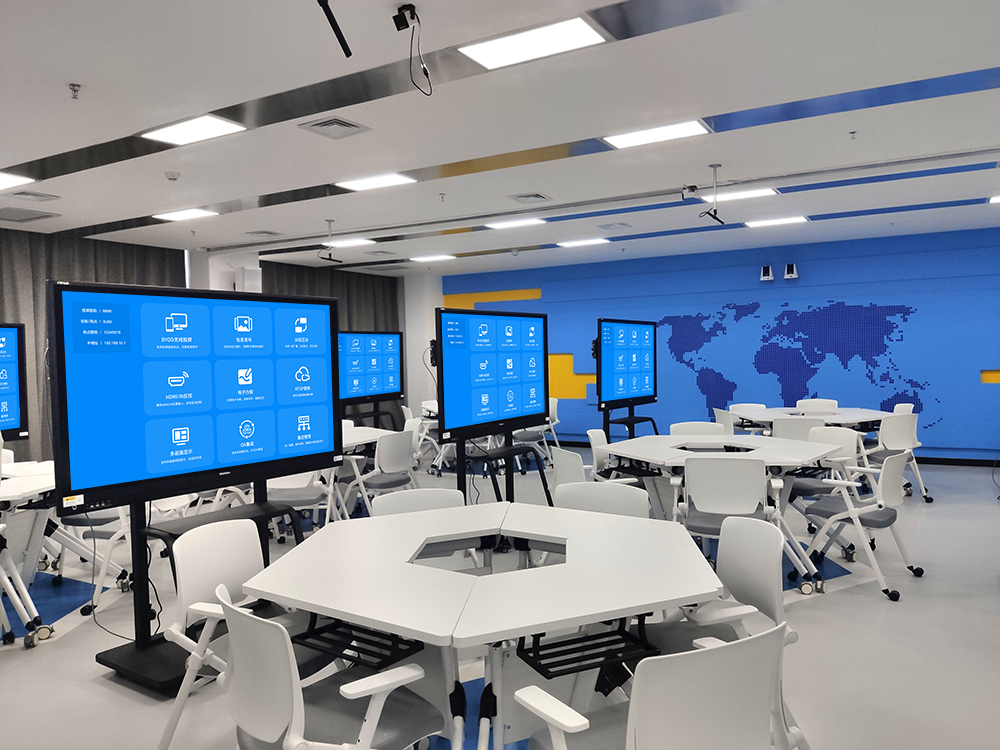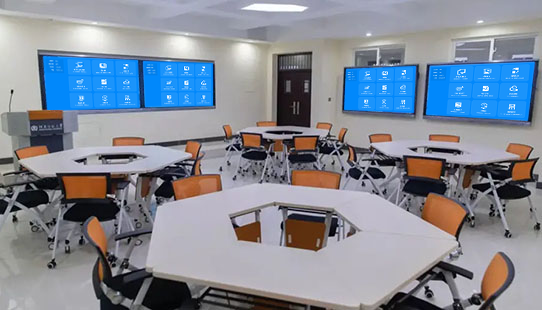Smart Classrooms: Building a New Paradigm for Interactive Education
The smart classroom solution is centered on “device interconnection, data-driven insights, and multi-dimensional interaction.” By leveraging technology, it reconfigures the classroom ecosystem, shifting teaching from a one-way output to a co-creation between teachers and students. This results in a dual improvement in the efficiency of knowledge transfer and the quality of critical thinking.
I. Core Architecture: All-Scenario Device Collaboration
(I) Multi-Protocol Wireless Interconnection
The system supports mainstream protocols like AirPlay, Miracast, and WiDi, covering all operating systems, including iOS, Android, and Windows. A teacher can use a MacBook to mirror a lesson plan, and a student can submit homework from an Android tablet with seamless integration, providing a device adaptation rate of 99%. Older devices can connect via a QR code mirroring feature, avoiding redundant purchasing costs.
(II) Multi-Screen Linkage Matrix
Using a “main screen + group screens” architecture, the main screen supports 4K touch display, and the group screens are 21.5-inch wall-mounted displays. All devices use a proprietary protocol for low-latency communication, with screen switching taking ≤1 second. The teacher’s main screen can view the discussion content of up to 6 groups in real-time. By clicking “push,” they can distribute important materials to a specific group, and a group’s results can be “pushed” to the main screen for comparison, creating a distributed interactive space.
II. Key Features: Interaction Throughout the Entire Teaching Process
(I) Real-Time Feedback System
A teacher can initiate question types like multiple-choice, fill-in-the-blank, or handwritten questions from a tablet. After students answer, a data dashboard is generated in 3 seconds, showing the accuracy rate, distribution of incorrect options, and a ranking of typical answers. In a math class, for a function problem with an error rate over 60%, the system automatically pulls up and pushes similar examples to student devices, enabling “immediate correction of mistakes.”
(II) Collaborative Annotation and Remote Control
The system supports up to 8 people using different colors to annotate on mirrored content simultaneously. A group leader can integrate annotations to generate a mind map. On the main screen, a teacher can directly annotate a student’s mirrored homework or remotely control a student’s device to flip pages, reducing the need to move around the classroom. In a chemistry lab class, a teacher can annotate key points of a test tube reaction on the main screen, with the annotations syncing to all student devices.
(III) Resource Consolidation and Reusability
The entire class is recorded in 4K, with mirrored content, student annotations, and answer data automatically linked to create a time-stamped class replay. After class, students can scan a QR code to review the material, fast-forwarding or pausing key segments to take notes, improving review efficiency by 50%. High-quality course resources are automatically archived to the cloud, categorized by “subject – chapter – knowledge point,” boosting teacher lesson preparation efficiency by 60%.
III. Scenario-Based Applications: Adapting to Diverse Teaching Needs
(I) Theoretical Classes: Visualizing Abstract Knowledge
- Dynamic Demonstrations: A physics teacher can mirror an animation of a mechanics experiment from a tablet, and students can use their phones to annotate the direction of forces, with the main screen summarizing the different annotations in real time. In an English class, students can use a voice mirroring feature to read a text aloud, and the system can automatically identify the accuracy of their pronunciation and mirror the feedback.
- Debate-Style Teaching: The pro and con sides can mirror their arguments to group screens, and the main screen can display a split-screen view of their competing ideas. A teacher can use a stylus to annotate logical flaws, and the debate is archived for post-class analysis of language expression and logical thinking.
(II) Lab Classes: Making Procedures Traceable
- Microscopic Demonstration: In a biology class observing a specimen, the microscope’s view can be magnified and mirrored to the main screen, allowing the whole class to annotate cell structures together. In a chemistry experiment, students can use their phones to film a reaction and mirror it to a group screen for slow-motion analysis.
- Safety Monitoring: Cameras deployed in the lab can be mirrored to the teacher’s device, allowing them to view each group’s actions in real-time. When a safety violation is discovered, the teacher can use a voice feature to provide an instant reminder, ensuring the safety of the experiment.
(III) Cross-Class Interaction: Enabling the Flow of Quality Resources
- Synchronized Classrooms: The main screen content of an urban teacher is synchronized in real-time to a rural classroom, and the rural students’ answer data is fed back to the main lecturer. Both sides can ask questions and communicate using a voice mirroring feature, allowing them to “be in the same class.”
- Collaborative Projects: Students from different classes can work in groups, sharing research data via cross-classroom mirroring. A history class and a geography class can collaborate to analyze the “impact of climate on dynastic changes,” with data flowing and being integrated across multiple screens to foster interdisciplinary thinking.

IV. Management and Operations: Lightweight Support for Teaching Stability
(I) Smart Management Platform
An administrator can view the status of all classroom devices via a dashboard, where data such as online rates, mirroring frequency, and error alerts are visualized. The platform supports remote power on/off and firmware updates. Devices automatically enter power-saving mode during non-teaching hours, reducing energy consumption by 30%. It can also pre-set scenario modes like “theoretical class” or “lab class,” allowing a teacher to switch device configurations with a single click and reducing their operational steps.
(II) Security and Access Control
- Content Moderation: Student-mirrored content must be approved by the teacher’s device before it can be displayed on the main screen, preventing irrelevant information from disrupting the class.
- Permission Levels: The teacher has full-screen control and content pushing permissions, while students can only mirror to their group screens, ensuring classroom order.
- Data Encryption: Classroom recordings and student answer data are encrypted locally, meeting educational data security standards.
V. Tangible Results: From Formal Interaction to Deep Participation
After a key middle school adopted this solution, the frequency of classroom interactions increased from 8 times per class to 25 times, and students’ active participation rate grew by 60%. A vocational school that implemented the solution saw the standardization of experimental procedures rise from 72% to 95%, with zero accidents. Through synchronized classrooms, a partnered urban-rural school saw the knowledge mastery rate of rural students increase by 40%.
The core of the smart classroom solution is for technology to serve the principles of teaching, not just for the sake of technology itself. By lowering the barrier to interaction, enriching interactive formats, and consolidating interaction data, it transforms teachers and students from “forced participants” to “natural collaborators.” This leads to a dual improvement in the efficiency of knowledge transfer and the quality of critical thinking, making the classroom a truly fertile ground for cultivating wisdom.